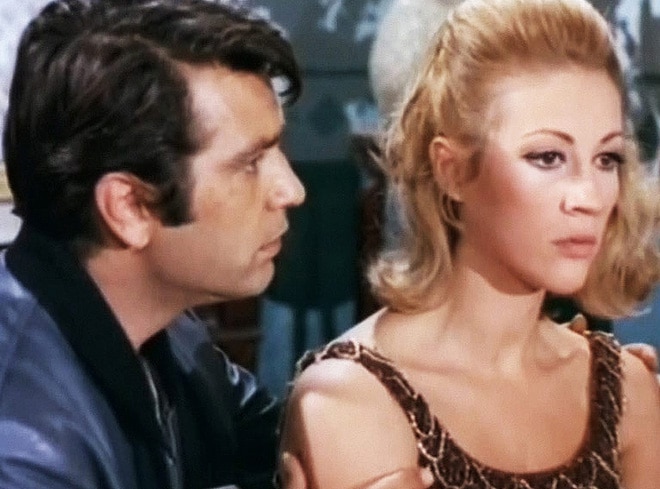Essay
Melancholic Musicals
by BILL MOUSOULIS

The Umbrellas of Cherbourg (Les Parapluies de Cherbourg)
(France, 1964, dir.: Jacques Demy)

Naked in the Street (Gymnoi sto dromo)
(Greece, 1969, dir.: Giannis Dalianidis)
The musical. Surely the film genre that divides people the most, eliciting reactions of hate or love, with any indifference or neutrality barely existing. The cinematograph was always destined to meet with music. Even silent films were accompanied by a piano player (real or mechanical). When sound was trialled, in the late 1920s, the recording of the singing voice was paramount – thus the legend of the Al Jolson film, The Jazz Singer (1927).
In the 1930s and ‘40s, the musical quickly grew into a major genre, even if most films had token song-and-dance routines thrown in. Luckily figures like Fred Astaire and Ginger Rogers could act as well. The genre reached its artistic zenith with directors like Vincente Minnelli (Meet Me in St. Louis, 1944, and The Band Wagon, 1953) and Stanley Donen and Gene Kelly (On the Town, 1949, and Singin’ in the Rain, 1952). These films sparkled for a general audience, but also had subtle riches for discerning viewers.
Being burdened, however, by the original mission of needing to be an ‘entertainment’ genre, the musical both dissipated and got renewed in the 1960s. West Side Story (1961) seemed to offer something different in the form of social comment, but soon the genre went tepid, with films such as Mary Poppins (1964) and The Sound of Music (1965). From there, in terms of Hollywood mainstream production, the genre truly went south, with only a very small number of musicals made each year.
The rejuvenation of the genre was mainly due to the French Nouvelle Vague. Starting in the late 1950s, directors Jean-Luc Godard, François Truffaut, Jacques Rivette and others, took over France’s ‘tradition of quality’ cinema and started making unusual films, with smaller budgets. The films were deconstructions of American genres and loving re-configurings of them. But while Godard’s musical A Woman is a Woman (1961) was in reality an ‘anti-musical’, lesser-profiled gang member Jacques Demy came up with something more in line with the classic Hollywood musical, with a twist: The Umbrellas of Cherbourg (1964).
The fact that The Umbrellas of Cherbourg is now generally considered one of the great musicals of the 1960s should not hide the reality that it started life as a troubled and experimental film. Demy, enamored with classic Hollywood musicals, wanted to make something resembling one of those films, with choreographed dance sequences to go along with the songs. But his producer Mag Bodard disappointed him, saying she could secure only limited funds to make the film. Undeterred, Demy decided to limit the film’s scope to that of a chamber piece, filming intimate scenes only, and with no dance sequences. The twist? Every line of dialogue is sung, like an opera, in a recitative style. The characters are ordinary people, another experiment (though wholly in line with the Nouvelle Vague’s ethos).
This radical idea triumphed and indeed allowed Demy to make a more conventional musical, with his subsequent film, The Young Girls of Rochefort (1967), complete with Gene Kelly in the cast. Suddenly the musical was alive again, paving the way for what film critic Adrian Martin has labelled “mutant musicals’ – a group of films that use the genre in unusual ways, films such as Sweet Charity (Bob Fosse, 1969), Golden Eighties (Chantal Akerman, 1983), Dancer in the Dark (Lars von Trier, 2000) and many others.
In 1964, the first viewers of The Umbrellas of Cherbourg were in no doubt they were witnessing something pure. Something new, but also something original and confident. The elements blended beautifully: Demy’s cinematic desire, Michel Legrand’s half-classical, half-jazzy score, Catherine Deneuve’s radiant beauty (her breakout film). Also, the story seemed perfectly-balanced between romance and reality. No conventional happy ending was offered, but the last scene left no-one untouched, and is now considered an extraordinary conclusion, one of the best in any film.
Demy’s masterstroke was to tap into the melancholy of love lost. The main musical theme in the film did the trick, repeated multiple times, a sad minor-chord sweep, in turns ascending and descending. It was this idea that was used in pivotal scenes (and brilliantly re-configured in the last scene), and in all publicity. Ironically, the rest of the film had more prosaic music, which meant of course that the main theme contrasted against it, giving it more impact. To express, like I said, love lost. Generally, a light and happy love is fleeting. It is made deep and lasting by loss or its maturation. This is its redemption and even glory.
There are other elements in The Umbrellas of Cherbourg, which stood out and gave it its unique quality: the art direction, with its bordering-on-kitsch decor and colours; the mise-en-scene, with carefully choreographed movements of the actors through the spaces; and the fluid camera movements provided by Nouvelle Vague regular Jean Rabier (Demy was a stylist influenced by the sweep of Max Ophüls’ cinema). There is also the stunning use of the port town Cherbourg, the film capturing its real streets and locations, but somehow making them seem like a fairytale land.
Demy went on to make more musicals. There is the follow-up Deneuve vehicle, The Young Girls of Rochefort, again with the distinct setting of a particular town, but this time with lots of dancing and a huge mosaic of characters and movements. It’s almost as good a film as The Umbrellas of Cherbourg, if somewhat less inviting. The success of these films emboldened Demy and several more distinctive musicals followed: Donkey Skin (1970), this time an actual fairytale; A Room in Town (1982), another recitative opera, but around protesting workers; and Three Seats for the 26th (1988), a wonderful ‘backstage musical’, with Yves Montand.
Working at the same time as bisexual Demy, i.e. roughly the three decades of the ‘60s, ‘70s, ‘80s, was another film director who was also gay and brilliant at making musicals: Giannis Dalianidis, in Greece.
Dalianidis was one of Greece’s most successful commercial directors, in conjunction with the Finos Films production company. Because of this, he is not as highly regarded artistically as he should be. There are, however, critics who value him, such as Australia’s academic Vrasidas Karalis. And Greece’s major art auteur Theo Angelopoulos also admired him. Furthemore, Dalianidis enjoys a cult following among film viewers. Young Melbourne cinephile-critic Frankie Kanatas is planning a website devoted to him (I acknowledge Kanatas as helping me thrill at and understand Dalianidis’ work).
In the early 1960s, Dalianidis made classic up-beat comedy-adventure-romantic musicals, such as Something Hot (1964) and Girls for Kissing (1965). In the late ‘60s and early ‘70s, on quite the roll, he introduced hippie elements to his musicals, which resulted in some very trippy and even surrealist works: The Blue Beads from Greece (1967), Mermaids and Wizards (1968), Marijuana Stop! (1971) and many others.
But it is his 1969 film, Naked in the Street, that is undoubtedly his masterpiece – maybe because it is atypical of his work. But maybe not. One could rate some of his other films very highly, too, even his non-musical ones, such as the ultimate tearjerker Maria in Silence (1973).
Naked in the Street is not a full-blown musical. The leads, played by the legendary Nikos Kourkoulos and Zoi Laskari, hardly sing in the entire film. There are a few songs here and there, with mainly the chorus of the town community singing them, but for me this film counts as a musical because of the exquisite score by renowned composer Stavros Xarchakos, who was a classical composer, but also a composer for singers like Nikos Xylouris.
Xarchakos’ score is like a blend of classical music with Greek popular ‘laika’ songs. It truly drives the film, its rich deep tones perfectly attuned to the down-beat, tragic melodrama as it unfolds. This is what connects Naked in the Street to The Umbrellas of Cherbourg – a melancholy, a tragedy of lost love and lost lives, lovers torn apart by time and circumstance.
Naked in the Street, past its opening introduction by the town madman/fool, begins with a stunning scene of a family group of 20 or so, at a wake, at night, in a courtyard, mourning. The film’s particular delirium, a sort of fever dream, starts at this point, with the textures of the night, the mournful music, and Nikos Kourkoulos, distraught and emotional, dancing a zeibekiko, the solo Greek folk dance, full of expression and release. Unbeknownst to him, he is being watched by Zoi Laskari, whose car has broken down. An icy, bored figure, something about the man’s dancing grips her. From there, this tragic story of two star-crossed lovers begins.
The film’s form is erratic, and it is sometimes marred by excessive melodramatic acting. At other times, the stylistics dominate, for example, two brilliant devices by Dalianidis: in the middle of some scenes, Dalianidis inserts close-up ‘frozen’ poses of some of the characters, in a bold expressionistic way; and, in other scenes, he has Kourkoulos and Laskari hold or look at each other, and they communicate telepathically, we hear their voices on the soundtrack, but they don’t actually speak (this reminds one of surrealist films such as Peter Ibbetson, 1935).
The film is mainly set at night, out in the open of the town’s streets, with the gangs/community of people always seemingly present during the drama between the lovers, like a Greek chorus, or indeed like the groups in West Side Story (obviously an influence on this film). There is a distinct artificiality to the sets. In this sense the film is similar to the way Demy uses his outdoor sets (ironically, they were real) in The Umbrellas of Cherbourg, namely in the service of the creation of a meta-reality (passion, romance, tragedy).
The Umbrellas of Cherbourg and Naked in the Streets questioned the musical genre. What it could do and what it could be used for. They opened the door for musicals that were not up-beat, joyful, fun and happy. These films are sad and deep, full of confusion, regret and tragedy. But they also offer redemption and hope – for The Umbrellas of Cherbourg in particular, the Nino Castelnuovo character is truly reconciled and happy at the end.
Currently, the musical is a genre that keeps chugging along, without offering anything groundbreaking. There are retreads, remakes, screen adaptations of new theatrical musicals, satires, and then a number of more alternative musicals, which are invariably low-budget and therefore unknown. The idea of the ‘mutant musical’ does linger, and at some point there will be another Umbrellas of Cherbourg, something totally unexpected and innovative. And it will probably come about by accident, like Demy’s acclaimed film did.
Works cited:
Kanatas, Frankie. “Political and Social Conventions in Jacques Demy’s ‘The Umbrellas of Cherbourg’”. Vague Visages, March 15, 2017. https://vaguevisages.com/2017/03/15/political-and-social-conventions-in-jacques-demys-the-umbrellas-of-cherbourg/
Karalis, Vrasidas. Realism in Greek Cinema: From the Post-War Period to the Present, London: I.B. Tauris, 2017.
Martin, Adrian. “Musical Mutations: Before, Beyond and Against Hollywood”. Movie Mutations: The Changing Face of World Cinephilia, edited by Jonathan Rosenbaum and Adrian Martin. London: British Film Institute, 2003.
Waldron, Darren. Jacques Demy. Manchester: Manchester University Press, 2014.
Bill Mousoulis is a Greek-Australian filmmaker who has made over 100 films, including 11 features, since 1982. He is also an occasional writer on film, and founder of the online film journal Senses of Cinema in 1999.

